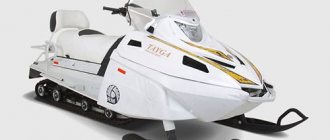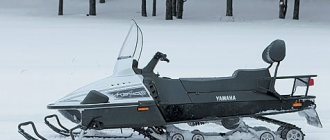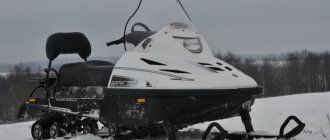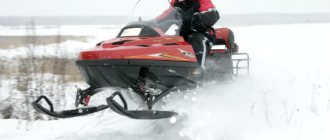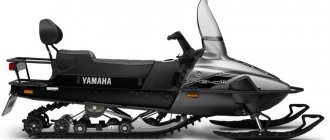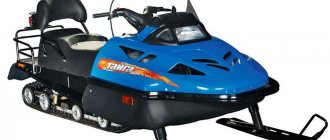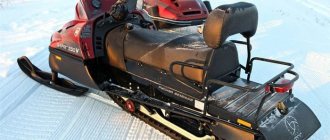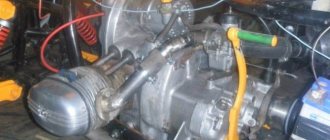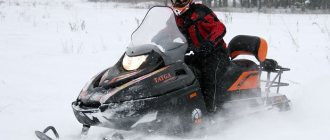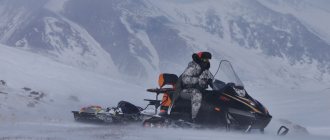All-terrain vehicles produced by Russian Mechanics OJSC are very popular among residents of the northern regions of not only Russia, but also other countries. Where winter recedes for a few short months, there is always a demand for such equipment. The Taiga line is considered the most successful among the company's products. It includes about a dozen models, each of which also has several design options. "Varyag" represents a multi-purpose Wide Track class vehicle with utilitarian properties.
The Taiga Varyag 550 snowmobile is distinguished by comfort and ergonomics, which were achieved thanks to a shift in the center of mass. In addition, the snowmobile has heated grips and a bright front headlight, which allows you to pilot special equipment in severe frosts and at night.
In addition, the model received a comfortable seat that will make even a long trip comfortable. “Varyag” is chosen not only by winter recreation enthusiasts, but also by residents of northern settlements for use for economic purposes.
A worthy answer from “Russian Mechanics” to the Japanese
Less than two years have passed since a surprise was prepared for fans of winter motor vehicles - the Taiga Varyag 550 V snowmobile, a fundamentally new utilitarian SUV, which in such a short time managed to fall in love with many and became the flagship among domestic snow all-terrain vehicles. The Rybinsk motorcycle concern has made every effort to create a machine that will work tirelessly in the difficult conditions of harsh Russian winters and overcome the deepest snow drifts without any problems.
Many have already noticed that the 550th “Varyag” is strikingly similar to the 540th model of the third generation “Viking”, which was released by the Japanese motorcycle giant Yamaha just for Russian impassable roads and work in the bitter cold. To say that RM has created a clone of a Japanese car would be completely wrong, since the Rybinsk “Varyag” has its own character and excellent characteristics. Probably, it was for these qualities that fans of overcoming snowy terrain immediately fell in love with it. Be that as it may, Varyag occupies a leading position in the domestic market, and the manufacturer rightfully has something to be proud of.
What determines the fuel consumption of the Taiga Varyag 550 V snowmobile?
It is no secret that its performance, speed and traction characteristics will depend on what engine is installed in the snowmobile. The operation of any SUV entails a certain consumption of gasoline. The Taiga Varyag 550 V snowmobile is no exception. The fuel consumption per 100 km for this car will vary depending on the conditions in which it will be operated, as well as on what engine and fuel system it is equipped with.
Reviews of the Taiga Varyag 550 V snowmobile from the owners of these machines regarding fuel consumption can be very ambiguous. The fact is that a new SUV consumes a large amount of gasoline during engine break-in. This figure can reach 36-40 liters for every hundred kilometers traveled. The increase in consumption is especially observed when driving a snowmobile in deep snow, overcoming various obstacles and significant unevenness on the road. Therefore, it is necessary to carry out the running-in on a flat, knurled track and not use an SUV during this period to perform household work.
It is recommended to run the Taiga Varyag 550 V snowmobile for at least 700 km. Fuel consumption for every hundred kilometers at the end of the run-in will be about 20 liters. Before you buy a snow SUV, it doesn't hurt to get the opinions of people who already use it. This also applies to a machine such as the Taiga Varyag 550 V snowmobile. In this case, owner reviews will help you decide on the choice of SUV model.
The lineup
The model range includes:
- Varangian;
- Patrol;
- ST 500D;
- Attack;
- Vector.
All models differ in technical parameters.
Varangian
Description and technical indicators:
| Motor model | RMZ-550 |
| Fuel fluid container | 55.3 l |
| Number of cylindrical elements | 2 |
| Engine power | 55 l. With. |
| Power unit type | Push-pull |
| Cylinder diameter | 7.6 cm |
| Piston stroke | 6.1 cm |
| Fuel system type | Two-carburetor |
| Carburetor model | Mikuni |
| Cooling system type | Air |
| Exhaust system | Silencer equipped with a resonator |
| Intake system | Reed valve |
| Lubrication system | Combined |
| Maximum driving speed | 80 km/h |
| Transmission of the snowmobile Taiga Varyag-500 | CVT SVT |
| Brake type | Hydraulic |
| Engine starting system | Manual and electric starter |
| Ignition | Capacitive, programmable |
| Reverse | Eat |
| headlight | Halogen |
| Speedometer | Eat |
| Front suspension type | Telescopic |
| Front suspension travel | 10.5 cm |
| Rear suspension type | Slimy |
| Ski track | 0.9 m |
| Track belt | 9.94*0.5*0.022 m |
| Rear suspension travel | 19 cm |
Patrol
Parameters and performance of the snowmobile Taiga Patrol 800 SWT:
| Highest speed | 105 km/h |
| Track Parameters | 3.93*0.6*0.022 m |
| Front suspension | Reinforced, telescopic, with increased stroke |
| Travel of suspension mechanisms | Front - 15 cm Rear - 19 cm |
| Rear suspension | Customizable |
| Shock absorber | Monotube |
| Gearbox type | Two-stage |
| Reverse | Eat |
| Number of speeds | 2 |
| Brake system type | Disc, hydraulic |
| Engine starting system | Electric |
| headlight | Halogen |
| Ignition mechanism | Multipoint fuel injection |
| Speedometer | Eat |
| Cylinder arrangement | V-shaped |
| Cooling system | Dual-circuit |
| Motor type | Four stroke |
| Power | 60 l. With. |
| Weight | 350 kg |
| Ski track | 0.96 m |
| Dimensions | 2.99*1.13*1.4 m |
Performance indicators of the Taiga Patrol 550 SWT:
| Power unit | RMZ-550 |
| Power | 55 l. With. |
| Motor type | Push-pull |
| Diameter of cylindrical elements | 7.6 cm |
| Piston stroke | 6.1 cm |
| Fuel device | Two-carburetor |
| Fuel cooling type | Air |
| Intake system | Muffler with resonator |
| Travel speed | 80 km/h |
| Starting system | Electric starter |
| Reverse | Eat |
| Ignition | Capacitive |
ST-500D
Technical parameters of the Taiga ST-500D model:
| Hanging mechanism | Telescopic |
| Rear suspension | Slimy |
| Number of shock absorbers on the front suspension | 2 |
| Mover | Crawler, with front drive sprockets |
| Number of tracks | 1 |
| Tension device | Screw |
| Track type | Reinforced, material - rubber + fabric |
| Track Length | 3.93 m |
| Track width | 0.5 m |
| Transmission model | Variable speed drive |
| Number of gears | 4 |
| Reverse | Eat |
| Brakes | Disc, adjustable |
| Brake drive | Hydraulic |
| Starting the power unit | Manual, with electric starter |
| Power supply system for electrical appliances | Carburetor |
| Ignition system | Ducati |
| Lubrication mechanism | Combined (oil + gasoline) |
| Fuel tank volume | 35 l |
| Number of seats | 2 |
| Travel speed | 80 km/h |
| Heated control levers | Eat |
| Windshield | Eat |
| Weight | 280 kg |
| Dimensions | 3.21*1.02*0.96 m |
Also on the market is the Taiga Ataka 551 I snowmobile model.
Attack
Technical indicators of this modification:
| Power unit model | RMZ-551 |
| Fuel tank capacity | 55.3 l |
| Number of cylinders | 2 |
| Motor power | 60 l. With. |
| Cylinder diameter | 7.6 cm |
| Piston stroke | 6.1 cm |
| Fuel device | Carburetor |
| Number of carburetors | 2 |
| engine's type | Push-pull |
| Carburetor type | Float |
| Cooling system | Liquid |
| Release mechanism | Muffler with resonator |
| Intake mechanism | Reed valve |
| Mechanism lubrication system | Separate |
| Highest speed | 100 km/h |
| Gearbox model | Variable speed drive |
| Number of speed modes | 4 |
| Reverse | Eat |
| Brakes model Taiga Attack 2 | Disc, hydraulic |
| Engine starting mechanism | Electric starter |
| Ignition | Capacitive, programmable |
| Heated grips | Eat |
| headlight | 55/60, halogen |
| Front suspension | Lever, stroke - 20.5 cm |
| Shock absorber | Twin-pipe, hydropneumatic |
| Weight | 320 kg |
| Track Dimensions | 3.93*0.5*0.022 m |
| Rear suspension travel | 37 cm |
| Ski track | 0.99 m |
Vector
Specifications:
| Motor model | RMZ-551 |
| Fuel fluid container | 55.5 l |
| Number of cylindrical elements | 2 |
| Engine power | 67 l. With. |
| Power unit type | Push-pull |
| Cylinder diameter | 7.6 cm |
| Piston stroke | 6 cm |
| Fuel system type | Two-carburetor |
| Carburetor model | Mikuni |
| Cooling system type | Air |
| Exhaust system | Silencer equipped with a resonator |
| Intake system | Reed valve |
| Lubrication system | Separate |
| Maximum driving speed | 105 km/h |
| Transmission | Variable speed drive |
| Brake type | Hydraulic |
| Engine starting system | Manual and electric starter |
| Ignition | Capacitive, programmable |
| Reverse | Eat |
| headlight | Halogen |
| Speedometer | Eat |
| Front suspension type | Lever |
| Front suspension travel | 22.5 cm |
| Rear suspension type | Slimy |
| Ski track | 1.1 m |
| Track belt | 3.96-0.5*0.03 m |
| Number of seats | 2 |
| Drawer sizes | 3.35*1.19*1.2 m |
| Rear suspension travel | 38.5 cm |
Less common models
Parameters of the Bars-850 model:
| Hanging device | Telescopic |
| Rear suspension | Slimy |
| Number of shock absorbers on the front suspension | 2 |
| Engine | Crawler, with front drive sprockets |
| Number of tracks | 1 |
| Tension device | Screw |
| Type of caterpillar | Reinforced, material - rubber + fabric |
| Track Length | 3.93 m |
| Track width | 0.6 m |
| Transmission model | Variable speed drive |
| Number of gears | 4 |
| Reverse | Eat |
| Brakes | Disc, adjustable |
| Brake drive | Hydraulic |
| Starting the power unit | Manual, with electric starter |
| Power supply system for electrical appliances | Carburetor |
| Ignition system | Ducati |
| Lubrication mechanism | Separated |
| Fuel tank volume | 50 l |
| Number of seats | 1 |
| Travel speed | 105 km/h |
| Heated control levers | Eat |
| Windshield | Eat |
| Weight | 330 kg |
| Ski track width | 0.96 m |
| Box dimensions | 3.08*1.19*1.2 m |
| Suspension travel | Front - 15 cm Rear - 38.5 cm |
| Dimensions | 2.95*1.15*1.46 m |
Design features of the 550 Varyag engine
Owner reviews on the operation of the Taiga Varyag 550 V snowmobile engine are very mixed. Some are confident in its reliability and moderate gasoline consumption, while others are not satisfied with the fact that the lubrication system is not combined with the fuel supply, and therefore they have to prepare the fuel mixture themselves. This is another reason why the Taiga Varyag 550 V vehicle’s fuel consumption per 100 km can exceed the 20-liter mark on a completely flat, knurled road.
The design feature of the machine is that it is equipped with an air-cooled two-stroke engine RMZ-550. The working volume of the two-cylinder engine is 553 cm³, and the car produces 50 hp. With. Fuel injection is carried out by a Japanese Mikuni carburetor installed on the snowmobile.
The intake manifold is represented by a petal-type valve, which allows it to produce good power at medium and low engine speeds. This, in turn, allows two passengers to ride and pull a sled with a load that can exceed 150 kg. At the same time, the car is capable of developing a fairly decent speed of 65-70 km/h. Without a loaded sled, the speedometer needle can confidently approach the figure of 80 km/h.
It’s easy to guess that the higher the engine load, the more gasoline the Taiga Varyag 550 V snowmobile will consume. Fuel consumption per 100 km can increase to 22.3 liters if you are carrying a significant load and there is a passenger on the snowmobile.
"Viking vs Varyag"
photo: Alexey Lenev and Alexey Fokin
The Yamaha VK540 III Viking snowmobile is one of the most popular foreign car models among domestic consumers. “Taiga Varyag 550” is Rybinsk’s new word in snowmobile building. Perhaps this is the first Russian snowmobile, which, without any reservations, from the very first announcement about its future launch into production, was recorded as a direct competitor to a foreign snowmobile.
In terms of technical characteristics, the Yamaha VK540 III Viking and the Taiga Varyag 550 can truly be called twins. However, like the history of the Vikings and Varangians itself. Vikings were the name given to medieval Scandinavian sailors in the 8th–11th centuries who made sea voyages from Vinland to Biarmia and from the Caspian Sea to North Africa. Swedish Vikings, as a rule, traveled east and appeared in ancient Russian and Byzantine sources under the name Varangians. Old Russian chronicles associate the formation of the state of Rus with the Varangians-Rus (“the calling of the Varangians”). The question of who was called the Varangians in Rus' continues to be controversial. But we can definitely say that now there is a Varyag snowmobile, which is very similar to the Japanese Viking. But, despite the large number of similarities, these “identical” ones have their differences.
| Controlling the gearbox on the VK540 III is more convenient than on the Varyag, but to switch from first to second gear and back, you must stop according to the instructions. Photo: Alexey Lenev and Alexey Fokin. |
| Ergonomics are simple but functional. The Viking's steering wheel is higher and more comfortable, the handles are turned towards the driver and lowered down. Photo: Alexey Lenev and Alexey Fokin. |
| The luggage compartment on a Japanese snowmobile is smaller, but, most importantly, the most necessary things fit. Photo: Alexey Lenev and Alexey Fokin. |
And, of course, the first thing that catches your eye is the red price tag “Taiga Varyag 550”. While the Yamaha VK540 III has the figures of 2010, 525 cm3, 288 kg, 299,000 rubles, the Taiga Varyag 550 has 2010, 553 cm3, 280 kg, 199,000 rubles. Does this mean a significant gap in quality? You can’t immediately give up, saying that the Russian one is not rated for extreme trips for hunting or other recreation, so we visually compared these two ski-tracked vehicles, and it turned out... And what turned out to be, we’ll find out below.
| photo: Alexey Lenev and Alexey Fokin |
| The size of the caterpillars is almost the same. The cross-country ability of the VK540 III is good, and due to the fact that the ski track is 6 cm wider, the stability is higher, but in terms of maneuverability it loses to the Varyag. Photo: Alexey Lenev and Alexey Fokin. |
So, the most important thing is the “heart” of the winter assistant - the engine. Both engines are two-stroke, two-cylinder, air-cooled, with Mikuni carburetors. The cylinder diameter/piston stroke for the Viking is 73/64, for the Varyag it is 76/61. The design of the intake manifold in the first one is a piston, a plate valve, in the second one there are reed valves. But these are all minor things. The VK540 III engine is equipped with a separate lubrication system, which, accordingly, eliminates unnecessary headaches regarding mixing fuel and oil. “Varyag” is deprived of such an advantage. And, despite the fact that according to the characteristics table, the Russian hero has an advantage in strength (Yamaha VK540 III - 46 hp, Taiga Varyag 550 - 50 hp), in reality this is not noticeable at all. And provided there are two riders on each of them, a speed of 80 km/h can be achieved from both snowmobiles. Although the volume of our fellow’s gas tank will be 7 liters larger than the foreign one, he also has an appetite to match. By the way, on the Viking the fuel level is monitored through a transparent gas pipe, while on the Varyag the control device is built into the gas tank cap. The main factor that brings inconvenience is the very noisy operation of our compatriot’s engine. Of course, if you travel with music in your ears, maybe someone will cross out this minus for themselves. Although you always want perfection from your favorite car, especially given the necessary silence so as not to scare away animals or other earthly creatures.
| photo: Alexey Lenev and Alexey Fokin |
Both machines are new generation utilitarian snowmobiles. The transmission is standard: a variator, two forward and reverse gears, the front suspension is telescopic struts with hydraulic shock absorbers (however, on the “Japanese” the suspension travel is 152 mm, while on the “Varyag” it is 115 mm). Slight difference in rear suspension. The Yamaha VK540 III has ProAction Plus with a quick adjustment system with two shock absorbers (hydraulic and gas-filled KYB shock absorber), while the Taiga Varyag 550 has one hydraulic shock absorber. However, the manufacturer says that the springs in the rear suspension have been strengthened, which eliminates the possibility of breakdowns during normal operation, and the wide tracks will not allow you to get stuck. While driving on the snowy off-road, the fighters showed their good side: they endured all the tests steadfastly and silently. True, the eastern comrade revealed his samurai nature and even jumping was not scary for him, but on the Varyag 550 it is better to avoid such tricks, just in case it’s safe. But the unconditional advantage of the domestic snowmobile was the ability to switch from first to second gear on the move. The “Japanese” won in terms of smoothness and greater traction at low revs.
| 90–100 km/h (according to the speedometer) is a speed quite achievable for the VK540 III and Varyag, if there is a long, clean straight line, without extra luggage and passengers. Photo: Alexey Lenev and Alexey Fokin. |
| The ski track distance and weight of the Varyag are smaller, so it shows good maneuverability and is easier to keep under control in a lateral tilt. Photo: Alexey Lenev and Alexey Fokin. |
| The Taiga Varyag 550 has a large luggage space under the seat (which is very useful on a hunting or fishing trip), but for the passenger the handles are low and with open steel, so the position is uncomfortable and the hands freeze. Photo: Alexey Lenev and Alexey Fokin. |
The feat of the Russian cruiser Varyag and its commander V.F. will forever go down in the history of the Russo-Japanese War. Rudneva. The news of the feat of the crews of the cruiser "Varyag" and the gunboat "Koreyets", who on February 9, 1904 took on an unequal battle with 14 warships of the Japanese squadron near the port of Chemulpo and, not wanting to surrender to the enemy, sank their ships, quickly spread throughout the world. In Russia, this caused a wave of patriotic enthusiasm and enthusiasm. “Varyag” is a proud name, which by definition should bring victory to its owner, so in our example they don’t just give up.
| photo: Alexey Lenev and Alexey Fokin |
But let's continue the comparative test further. Despite our country's dedicated experience, we are also familiar with Japanese impeccable manufacturing. Therefore, there is no need to talk much about the ergonomics and comfort of snowmobiles. Of course, Viking is the leader in these indicators. Behind the wheel of the VK540 III you feel more comfortable due to the driver’s seating position being slightly higher. The steering wheel handles are turned towards the driver and slightly lowered down. And the seat is more comfortable, this is especially noticeable for the passenger. On the “Varyag 550” the seat is harder (princesses stay at home on their feather beds) and shorter by 4–5 cm. But the domestic “snowball” has a larger open luggage platform and a more spacious space under the seat where all the gear, supplies and various necessary little things can fit . By the way, the Varyag’s battery is located in the same place, under the seat.
| photo: Alexey Lenev and Alexey Fokin |
If you remember, at the very beginning of our comparison we talked about quality - is it equally correlated with price. We have already talked about Japanese reliability, but about the quality of the product of domestic manufacturers, the opinions of many users, to put it mildly, are far from clear and not very reassuring.
We have all grown up a long time ago and stopped believing in fairy tales, and many, alas, do not believe in miracles
| photo: Alexey Lenev and Alexey Fokin |
| Personally, it seemed to me that the steering column of the domestic snowmobile is located slightly lower compared to its Japanese counterpart. Given the overall low fit, this reduces overall comfort and convenience. Although if the Rybinsk masters had not been stingy and equipped the rudders with a central line, then one point in their favor would have been clear... Photo: Alexey Lenev and Alexey Fokin. |
Life often throws curveballs, so we have stopped taking their word for it - we check, test and draw conclusions. Today's result is the Yamaha VK540 III and the Taiga Varyag 550, although they are very similar, but in their parameters they fully correspond to their price/quality ratio. The Viking is a time-tested snowmobile, a universal workhorse, and the Russian hero has yet to be tested in the snowy expanses of the country. But, of course, he will also find his fans; it is no coincidence that he bears the proud name “Varyag”.
Andrey Shushpanov January 26, 2011 at 5:51 pm
Chassis "Varyag"
The engineers seemed to have heard reviews from the owners about the Taiga Varyag 550 V snowmobile. Fuel consumption is now significantly reduced. A fundamentally new chassis of the Varyag was installed. Let's look at this point in more detail. The fact is that low cross-country ability, poor maneuverability and controllability of the vehicle force the engine to mercilessly destroy the fuel supply. The designers decided to install on the 550th Varyag model the telescopic front suspension from the 850th Barca, also of the Taiga series. What did it give? The 143 mm free stroke of the rod significantly increases the smoothness of the machine's movement and significantly reduces the force transmitted to the steering. But the rear suspension now has a free travel of 277 mm, while the shock absorber has taken a position in the horizontal plane, which made it possible to dissipate impacts while overcoming bumps.
The 508-mm Varyag tracked base is presented by Magnum. The height of the lugs is quite significant and amounts to 32 mm. Taken together, this improved dynamic performance during acceleration and also ensured confident braking. In addition, the “Varyag” is stable, confidently takes even the most difficult turns and overcomes steep climbs. It is equipped with a high-quality variator, ensuring smooth operation regardless of load conditions. Even starting the car from a standstill at low engine speeds occurs smoothly, without jerking, which also does not lead to excessive fuel consumption. Reducing the force on the lever was achieved thanks to the installation of a hydraulic brake system. Thanks to this, the machine has good reliability and is safe to use. Therefore, the Taiga Varyag 550 V snowmobile has positive reviews.
Specifications
Dimensional data:
- The structural length of the snowmobile is 2990 millimeters.
- Width – 1050 millimeters.
- Total height – 1380 millimeters.
- The total length of the track is 3937 millimeters.
- The width of the caterpillar track is 500 millimeters.
- The height of the caterpillar track is 22 millimeters.
- The track width between the ski centers is 900 millimeters.
- The track base of the snowmobile is 508 millimeters.
Operational values:
- Structural weight – 280 kilograms.
- The model of the installed engine is RMZ-550.
- Engine starting type – electric starter.
- The type of rear shock absorber of the propulsion unit is hydropneumatic single-tube.
- Fuel tank capacity is 40 liters.
Transmission:
- The type of optionally installed transmission is two-stage.
- The type of transmission installed is CVT.
- Number of speeds – 4: low, high, reverse, neutral.
Brakes:
- Control type – hydraulic.
- Braking mechanism type: mechanical disc.
Suspension:
- Front suspension type: telescopic.
- Front suspension travel is 105 millimeters.
- Rear suspension type: slip.
- Rear suspension travel is 190 millimeters.
Electrical equipment:
- Ignition system type – DUCATI CDI (capacitive programmable).
- Front headlight type: halogen.
- Heated steering wheel and throttle trigger are optional.
About comfort and ease of use
We can say with complete confidence that the manufacturers took care of the convenience of users and created the 550th model that is comfortable, beautiful and modern. In general, all all-terrain vehicles of the RM Taiga series have these qualities, and not just the Taiga Varyag 550 V snowmobile. Owner reviews confirm this fact. Judge for yourself: the car has high cross-country ability, and this applies not only to snowy roads. “Varyag” easily overcomes various holes, shallow reservoirs, impassable mud and high climbs. In addition, the machine can be operated not only at sub-zero temperatures in winter. It is not afraid of heavy rains and thick snow, and in terrain where there is knee-deep mud, the Varyag will fly unnoticed by the rider. Although after such trips you will have to wash your overalls and wash your snowmobile. But these are small things compared to the capabilities of a powerful SUV.
As we have already said, the 550 model is equipped with hydraulic brakes, which significantly enhances the safety of the driver and passenger. In addition, the developers have significantly reduced background noise. Now in the car, not only the noise from the exhaust manifold has become much lower, but under the hood of the all-terrain vehicle there is high-quality insulation, which makes the engine much quieter.
Advantages and disadvantages
To get a more complete picture of the pros and cons, you should look at reviews, read reviews of the Taiga Varyag 550 snowmobile - reviews from owners, opinions of independent experts form an objective assessment of any product, including special equipment.
What are the advantages of Varyag 550
Most models in the Tayga line are capable of accelerating from 60 to 100 kilometers per hour. Moreover, they behave equally well both on a road with a compacted track, dense snow cover, and on freshly fallen wet or loose snow. This distinguishes them favorably from their older brother, who also came off the Rybinsk assembly line.
Although the Varyag 550 is positioned as a budget all-terrain vehicle, it has a fairly powerful engine that can withstand heavy loads. This has a positive effect on its utilitarian qualities. A reliable towbar allows you to pull a load weighing up to a quarter of a ton. At the same time, the snowmobile will confidently carry the pilot and passenger.
Among the advantages are:
- build quality, good finish;
- powerful power unit;
- high traction qualities;
- good handling;
- simple maintenance.
In addition, the all-terrain vehicle has a high rear suspension and a bright halogen lamp. This modification also has a comfortable backrest for the passenger seat.
What disadvantages were noticed
Without going into too much detail, we can say that this snowmobile represents the perfect balance of price and quality. However, like any technique, it is not without its drawbacks.
These include:
- the seats are too hard and not suitable for long trips;
- relatively small power reserve;
- high gasoline consumption;
- no seat heating;
- there is no water circuit for cooling;
- long break-in period.
For the most part, the owners of this Varyag model do not regret their purchase. Some note the high cost of the new model at dealers. The manufacturer explains this simply - the design of the snowmobile uses many imported parts (Italian ignition system, Japanese carburetor), which are much more reliable than domestic ones.
In addition, even those elements that are assembled in Russia are often also made from imported materials.
About some of the machine's capabilities
The steering on the Varyag is located high, making driving the car much more convenient.
The handles are equipped with rubberized pads, which makes them ergonomic. If the snowmobile falls upside down, the heavy-duty glass will not break and will remain the same as before the impact. This was made possible thanks to the use of special polycarbonate fiber. In addition, the windshield provides the rider and passenger with reliable protection from oncoming gusts of wind and snow.
Traveling through deep forest thickets is also not scary for the Varyag. The blows of branches and trees will be absorbed by the glass and hood, and the snowmobile can easily overcome the most difficult irregularities thanks to the breaking heel on the rear suspension. This also helps ensure that when reversing, it will not get stuck in deep snow.
The luggage compartment of the car is spacious, and you can put up to 100 kg of hand luggage there. In addition, there is a place under the driver’s seat for some things and various tools. With a vehicle weight of only 280 kg, you can drag a load of over 200 kg behind you on a drag sleigh or sled, for which a tow bar is provided in the snowmobile. Well, if the need nevertheless arises to increase the space for luggage, no one bothers to install a comfortable and roomy chest. Fishing gear and hunting accessories can also be stored here.
How is the Taiga Varyag 550 V snowmobile controlled? Owner reviews
The steering of the Varyag is designed in such a way that the rider can be quite comfortable in a standing position and control the car. In early versions this was quite problematic due to the low position of the steering wheel, and the windshield interfered with visibility. This problem has been completely solved by the developers of the 550 Varyag.
The snowmobile accelerates quite quickly and picks up good speed without any problems. When moving, the car moves smoothly and softly, which is facilitated by the telescopic suspension and powerful engine. In general, coping with road “delights” is not a serious problem for the Varyag. And to overcome the forest thicket, it is enough to reduce the distance between the skis, and it will be much easier to control the snowmobile.
Despite the fact that the Varyag is still a utilitarian snowmobile, in skillful hands it can overcome significant ascents and descents, as well as perform complex maneuvers.
Which plant produces the unit?
The Tayga snowmobile is considered one of the most successful lines produced by the Rybinsk Machine-Building Plant. The first prototype was released in 1988, but only ten years later, after a number of modifications, its production was put on the assembly line. Varyag 550 represents a budget type of motorcycle-type snowmobile equipment, adapted to the harsh conditions of our country.
In this model, design engineers combined comfort, ease of use and accessibility. First of all, the manufacturer was guided by the fact that the equipment would be used for economic purposes.
“Russian Mechanics” traces its history back to the times of the Soviet Union. Initially, the enterprise was part of Rybinsk Motors OJSC. It was from his assembly line that the first domestic snowmobile “Buran” rolled off, which at one time was a stunning success. The new enterprise is a full-fledged successor and continuer of the best traditions of Soviet mechanical engineering in the field of special equipment.
Currently located in the Yaroslavl region in the suburbs of Rybinsk. All-terrain vehicles that came off his assembly line are popular not only in Russia, but also in neighboring countries. All products of the plant undergo multi-level quality control and comply with European standards.
About ease of movement
We have already considered in the article both the characteristics and capabilities of the engine, and the design features of the chassis. Now a few words about snowmobile skis. Gliding not only on snow, but also on other types of surfaces depends on the quality of skis. In addition, they experience greater stress, as this is facilitated by the sheer weight of the snowmobile and continuous friction with the road. Therefore, skis can quite often wear out and fail, despite the special strength of the plastic from which they are made. Therefore, it is recommended to use special pads that do not in any way affect the deterioration of the cross-country ability and speed qualities of the snowmobile.
About the advantages of a snowmobile
Utility machines are good in almost all applications. They can be used for short walks, and for transporting various loads, as well as for overcoming deep snow and off-road conditions. Such machines include the Taiga Varyag 550 V snowmobile. Owner reviews helped put together the overall picture of this SUV. We can clearly conclude that:
- “Varyag” is a supple and obedient SUV.
- Easily overcomes obstacles and moves on various types of road surfaces.
- With proper care after running-in, the Varyag consumes about 18 liters for every 100 km traveled. A 40-liter tank is enough to cover 220 km.
- Modern appearance, nice design, increased comfort and excellent maneuverability.
- Comfortable seating and easy operation of the machine.
- It is quite roomy and allows you to transport a considerable amount of cargo.
- Starts quickly. It pulls equally well in both impassable mud and deep snow.
- It starts with an electric starter at very low temperatures (-37 ºС) without preheating the engine.
